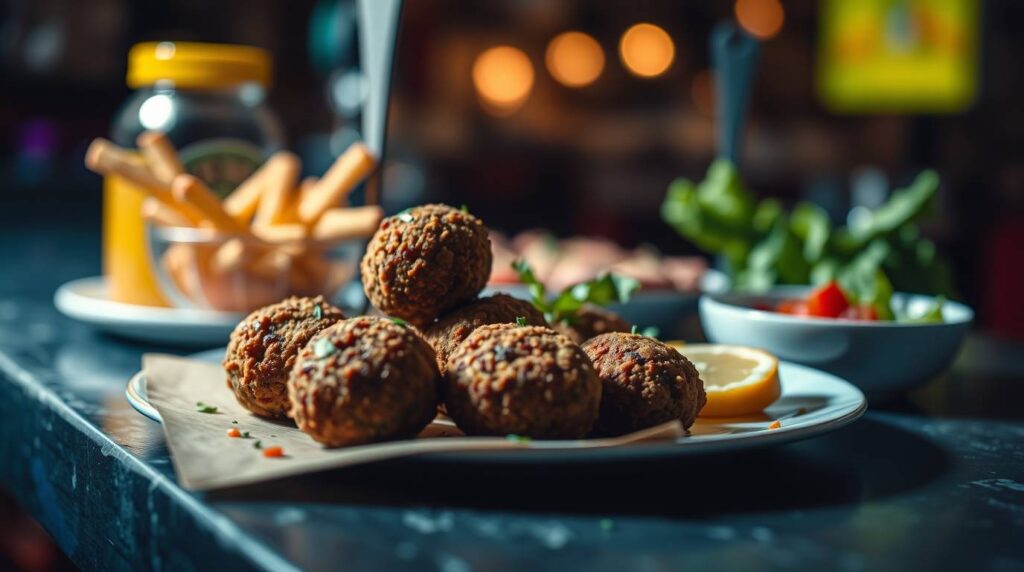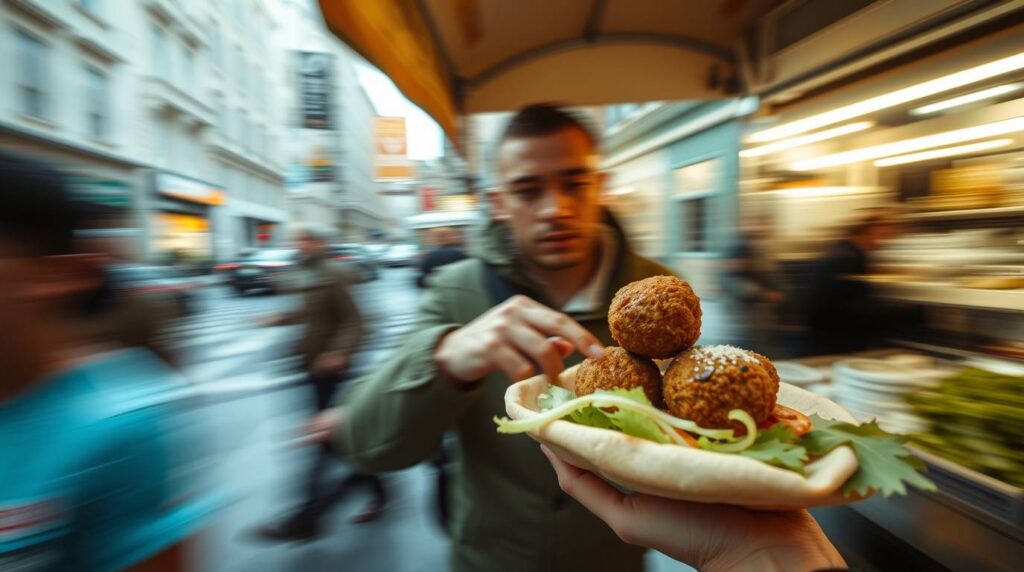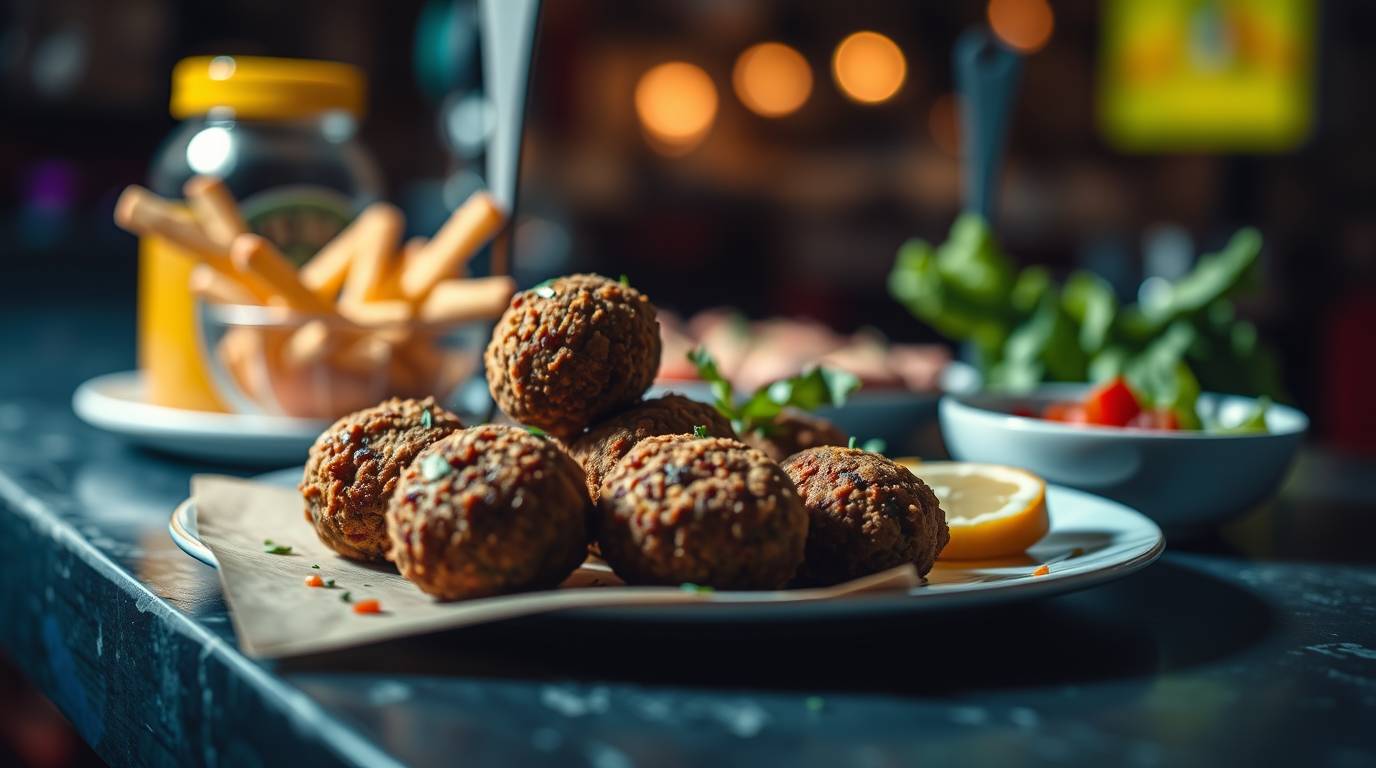
The first time I tasted truly authentic falafel was on a balmy evening in Jerusalem’s Old City. I had wandered down a narrow, cobblestone alley following the irresistible scent of spices and sizzling oil. An elderly man stood behind a modest cart, his hands moving with practiced precision as he shaped and fried small green patties. When he handed me that warm pita stuffed with freshly fried falafel, drizzled with tahini and topped with pickled vegetables, I knew my culinary life would never be the same.
As an Israeli vegan chef, falafel has become one of my signature dishes. After years of perfecting my technique and learning from local masters, I’m thrilled to share my authentic falafel recipe with you – complete with three different cooking methods to suit any kitchen.
Why This Authentic Falafel Recipe Stands Apart
Many Western falafel recipes cut corners by using canned chickpeas, resulting in mushy patties that fall apart. The secret to authentic, crispy falafel lies in using dried chickpeas soaked overnight – never canned! This traditional method creates that perfect contrast between the crunchy exterior and tender, herb-flecked interior that makes falafel so irresistible.
What sets this recipe apart:
- Authentic technique using overnight-soaked dried chickpeas
- Perfect texture – crispy outside, fluffy inside
- Three cooking methods – deep-fried traditional, healthier air-fried, or oven-baked
- Balanced spice blend combining cumin, coriander, and fresh herbs
- Versatile serving options for mezze platters, wraps, or bowls
This plant-based protein powerhouse has sustained people across the Middle East for centuries. In Israel, you’ll find falafel stands on practically every corner, each with its own loyal following and secret family recipe passed down through generations.
The Ancient Origins of Falafel

During my travels through Egypt, Lebanon, and across Israel, I discovered that the humble falafel has a contested history, with multiple countries claiming to be its birthplace. The most compelling evidence suggests falafel originated in Egypt, where it was made with fava beans (called ta’amiya). As it spread northward through the Levant, chickpeas became the preferred base, creating the version we’re most familiar with today.
In Tel Aviv’s bustling Carmel Market, I spent time with a third-generation falafel maker who explained how his grandfather brought the recipe from Alexandria, Egypt in the 1950s. He shared that the key to exceptional falafel is not just in the ingredients but in understanding the perfect coarseness of the mixture – not too fine and not too chunky.
Why Dried Chickpeas Are Non-Negotiable
The most critical element of authentic falafel is starting with dried chickpeas soaked overnight. This isn’t just tradition – it’s science! Dried chickpeas retain their structure and starch content, which acts as a natural binder. Canned chickpeas have already been cooked, breaking down this crucial structure and resulting in falafel that either falls apart or becomes dense and heavy.
The soaking process activates enzymes in the chickpeas, making them more digestible while maintaining their firm texture. This simple step transforms your falafel from good to exceptional, giving you that authentic street food experience right in your own kitchen.
What many don’t realize is that traditional falafel contains no flour, eggs, or other binders – just the natural starches from properly prepared chickpeas holding everything together. If your mixture isn’t holding together, you’ve likely over-processed it or used chickpeas that weren’t properly soaked.
Three Perfect Cooking Methods for Any Kitchen
While deep-frying produces the most authentic falafel, I understand that many home cooks prefer healthier options or want to avoid the hassle of dealing with hot oil. That’s why I’ve perfected three distinct cooking methods:
- Traditional Deep-Fried: The classic method producing the crispiest exterior and most authentic flavor. The key is maintaining the oil at exactly 340°F (170°C) – not hotter, not cooler.
- Air Fryer: My go-to method for weeknight cooking. Air-fried falafel develops a wonderful crispy exterior with minimal oil, making it 75% lower in fat than traditional versions.
- Oven-Baked: Perfect for making large batches. While slightly drier than the other methods, brushing with olive oil before baking helps maintain moisture and develop a golden crust.
No matter which method you choose, the critical step is handling the mixture gently. Over-packing the falafel will make them dense rather than light and airy.
Try this authentic falafel recipe and bring a taste of Jerusalem’s old city to your table. Pair it with homemade hummus, fresh pita, and a simple Israeli salad for a complete Middle Eastern feast that will transport you straight to the vibrant streets of Tel Aviv!

Equipment
- Food processor
- Ice cream scoop or cookie dough scoop (optional)
Ingredients
Falafel Base
- 2 cups dried chickpeas measured before soaking
- 1 cup flat-leaf parsley packed
- 1/2 cup mint leaves or cilantro, optional
- 1 yellow onion
- 6 cloves garlic
Spices & Seasonings
- 2 teaspoons ground coriander
- 1 1/2 teaspoons ground cumin
- 1 1/2 teaspoons salt
- 1/4 teaspoon black pepper
- 1/4 teaspoon cayenne pepper or chili powder
- 2 teaspoons baking powder
For Cooking
- 1 tablespoon olive oil for air frying or baking
- 4-6 cups frying oil for deep-frying (optional)
Instructions
- SOAK THE CHICKPEASSoak 2 cups dried chickpeas in a large pot with plenty of water for 24 hours. The chickpeas will expand to about triple their size.
- BLEND INGREDIENTSTo a food processor, add parsley, mint leaves, onion (quartered), garlic cloves, ground coriander, ground cumin, salt, black pepper, and cayenne pepper. Blend until finely chopped.
- Add the soaked and drained chickpeas and baking powder. Blend until finely coarse (not pureed), scraping down the sides of the food processor once or twice. The mixture should be like coarse sand that holds together when pressed.
- SHAPE THE FALAFELShape the falafel by hand or use a scoop. Form small balls (about 1-1.5 inch diameter) and gently press to flatten slightly. The mixture should stick together easily and hold its shape.
- If the mixture doesn’t hold together, add 2 tablespoons of all-purpose flour or chickpea flour to help bind it. Rinse your scoop with water occasionally to prevent sticking.
- COOK THE FALAFELAIR FRYER METHOD: Brush the air fryer basket with olive oil. Arrange the falafels in a single layer. Air fry at 400°F (200°C) for 12-15 minutes until golden brown and crispy.
- OVEN-BAKED METHOD: Preheat the oven to 350°F (180°C). Use convection/fan setting if available. Arrange falafel on a baking sheet lined with parchment paper. Brush them with olive oil to prevent drying out. Bake for about 30 minutes until golden brown.
- DEEP-FRY METHOD: Heat oil in a deep pot to 340°F (170°C). Carefully drop falafels into hot oil, frying 3-4 at a time for 3-4 minutes until golden brown. Turn occasionally for even cooking. Transfer to paper towels to drain.
- SERVEServe falafel warm with pita bread, on a bed of hummus, with tahini sauce, fresh herbs, or as part of a mezze platter with various dips and salads.
